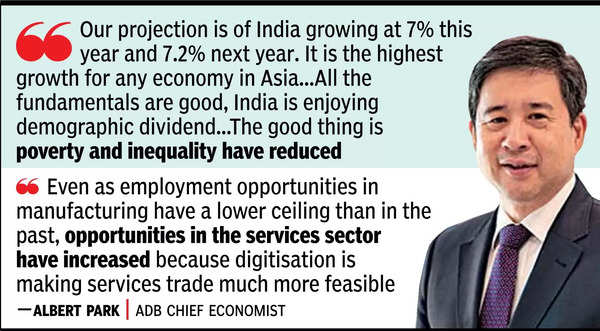
Asian Development Bank (ADB) chief economist Albert Park is in the capital for the Kautilya Economic Conclave. In an interview, he told TOI that the agency is keeping a close eye on global crude oil prices to assess the impact of the escalating conflict in West Asia on the region and advocated that trade and investment channels should remain open. Quote:
How do you see developments in India in the last three to four years? Is there a sense of comfort in the economy?
Govt focuses on growth and they try to understand the costs and benefits of various economic policies in a pragmatic way. The pragmatism leads to good results because we see significant govt investment in infrastructure, efforts to reduce the regulatory burden on companies and more easily. from doing business. The goal is to improve economic activity, improve productivity, promote more investment, and create more jobs.
Is there anything that needs to be done to increase the growth rate and what needs to be done because work is the main problem?
Our projection is that India will grow at 7% this year and 7.2% next year. This is the highest growth for any economy in Asia. It may grow faster but the main thing is not to focus on any number, just keep thinking about how the basic environment for business can improve. All the fundamentals are good, India enjoys a demographic dividend and a lot of positive sentiment among consumers and investors.
Employment is an important issue. The good thing is that poverty and inequality have decreased. If you’re trying to create more jobs for low-skilled sectors, then you should encourage manufacturing and labor-intensive sectors that have a comparative advantage. The success of Tamil Nadu and Gujarat is the right way to go, and we should think about how other states can do it.

Is it possible to create the same amount of work as before, due to higher mechanization and digitization?
There may be some truth, but I’m not sure if it affects our strategy, the labor-intensive sector still creates a lot of jobs. Although employment opportunities in manufacturing have a lower ceiling than before, opportunities in the service sector are increasing as digitalization makes trade in services more viable. India has benefited from it… the only concern is that they tend to be more skill intensive. India must press on all fronts. There are many synergies between manufacturing and services.
There are fears that excess capacity in China (due to the slowdown) could affect other markets as subsidies are provided…
There are no rules on how much you should produce in a global economy. If you think this represents an unfair trade practice, we have WTO principles to guide us as to what justifies a countervailing or anti-dumping duty. States, instead of politicizing trade, should adhere to these principles and do due diligence and enforce what is appropriate.
Do you see a shift due to the China Plus One strategy, including for India?
We have seen changes in FDI and trade flows. The countries that benefit the most are also competitive producers. Countries with a good investment environment have benefited, Vietnam, India, to some extent, Mexico due to its proximity to the US. India and Indonesia also benefit from being large markets. This is an opportunity, in particular, if it gives a foothold to a new sector, the semiconductor chain, anything related to the green transition. For India to maximize profits, it is necessary to provide a very attractive investment environment, which can improve over time. Just subsidizing it will not be sustainable.
India has scrutinized investments from countries that share land borders, a move aimed at China, on security grounds. There are suggestions that reducing investment could help reduce the trade deficit. How do you see it?
Security is a non-economic factor and the government must determine its priorities. From an economic point of view, you have to minimize the limit. I want the US and the EU to also take the view that the trade balance is not good, allow Chinese companies to invest and produce. This creates more jobs and local technology transfer.




